Abstract
We evaluated the activity of ampicillin and chloramphenicol in vitro and in vivo against an Escherichia coli K1 strain. In vitro, the strain was relatively susceptible to both antibiotics (MIC and MBC of ampicillin, 2 and 4 micrograms/ml; MIC and MBC of chloramphenicol, 4 and 64 micrograms/ml). Checkerboard determinations of MBCs of drug combinations were consistent with antibiotic antagonism. Killing curves with concentrations of antibiotics similar to in vivo levels in blood and cerebrospinal fluid of infected rats indicated antagonism within the first 4 h and an indifferent effect of the combination at 24 h. Paradoxically, the combination was significantly more effective than ampicillin or chloramphenicol alone in vivo in infant rats. This was shown by (i) more rapid bacterial clearance from the blood and cerebrospinal fluid, (ii) a decreased incidence of meningitis in bacteremic animals, and (iii) improved survival. These findings illustrate a divergence between the effects of ampicillin and chloramphenicol against E. coli in vitro and in vivo and suggest that this combination is an effective synergistic regimen in this experimental model of E. coli bacteremia and meningitis.
Full text
PDF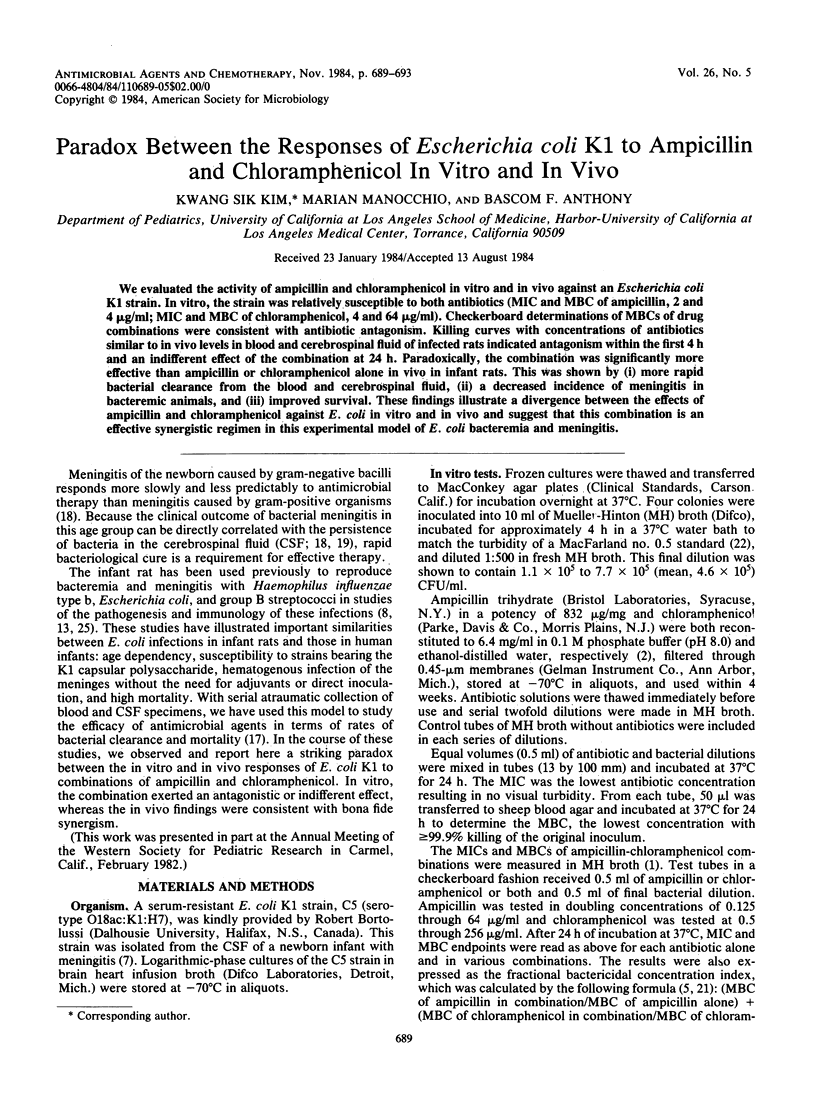
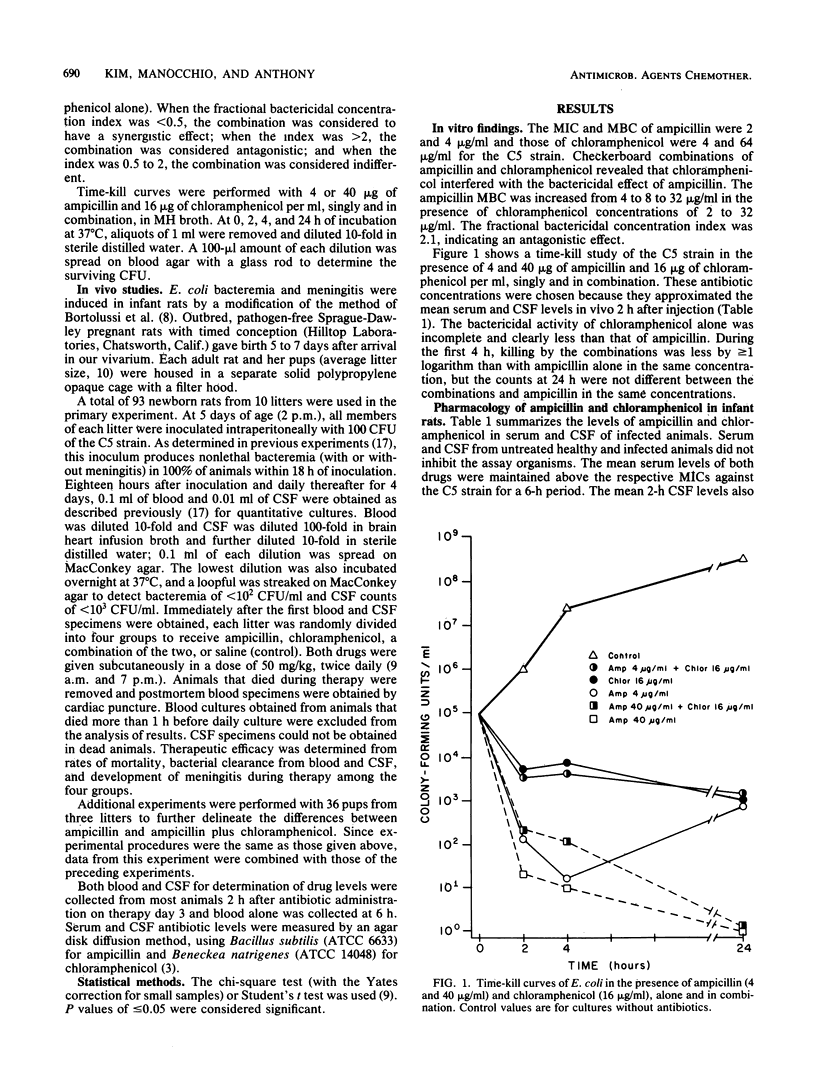
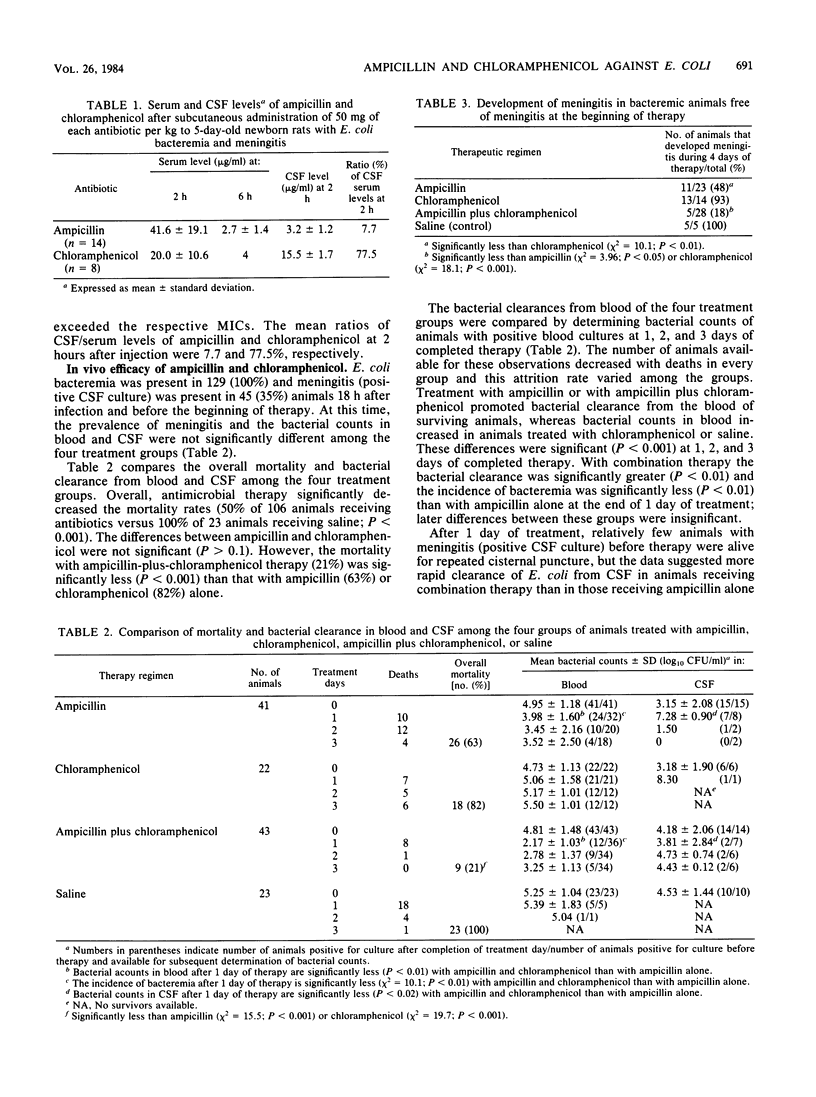
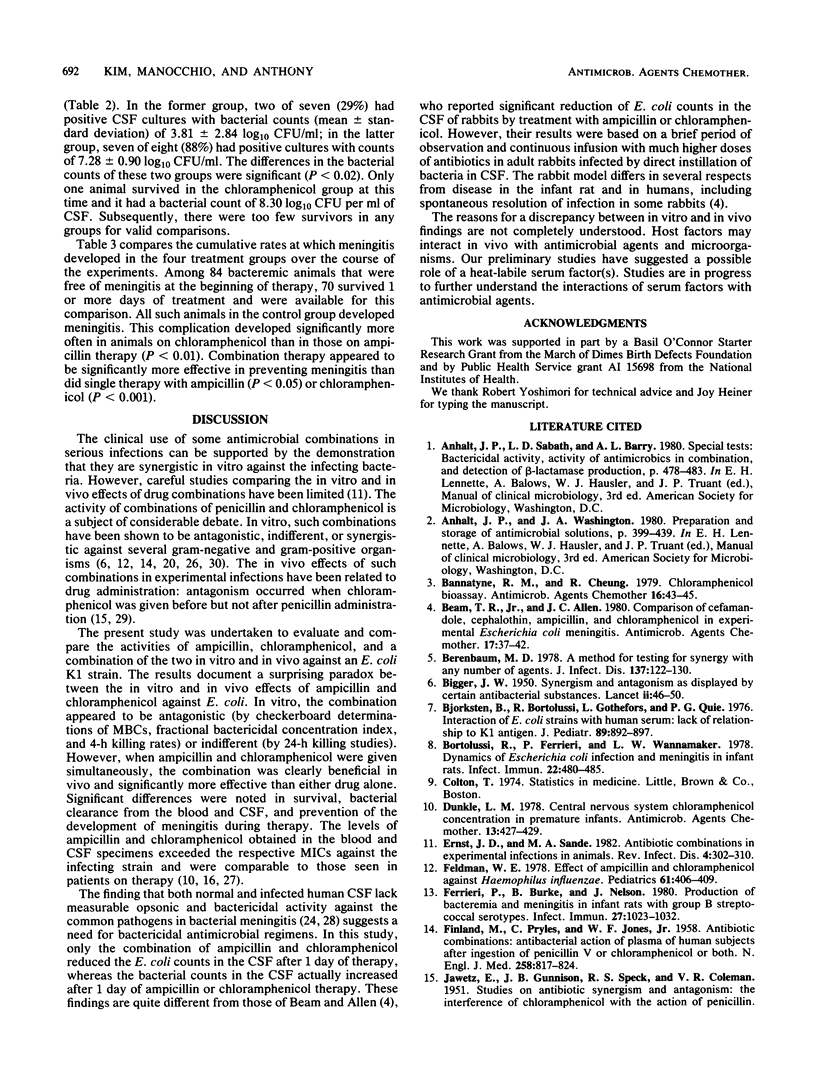
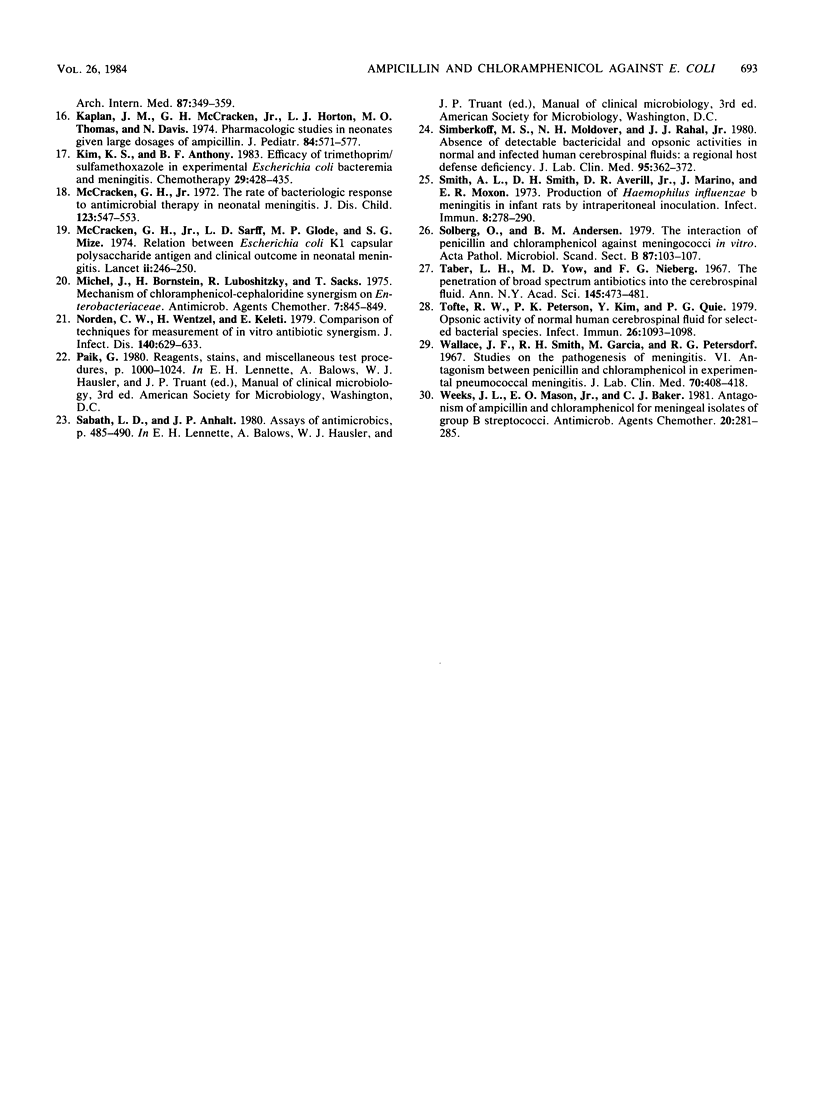
Selected References
These references are in PubMed. This may not be the complete list of references from this article.
- BIGGER J. W. Synergism and antagonism as displayed by certain antibacterial substances. Lancet. 1950 Jul 8;2(6619):46–50. doi: 10.1016/s0140-6736(50)90990-1. [DOI] [PubMed] [Google Scholar]
- Bannatyne R. M., Cheung R. Chloramphenicol bioassay. Antimicrob Agents Chemother. 1979 Jul;16(1):43–45. doi: 10.1128/aac.16.1.43. [DOI] [PMC free article] [PubMed] [Google Scholar]
- Beam T. R., Jr, Allen J. C. Comparison of cefamandole, cephalothin, ampicillin, and chloramphenicol in experimental Escherichia coli meningitis. Antimicrob Agents Chemother. 1980 Jan;17(1):37–42. doi: 10.1128/aac.17.1.37. [DOI] [PMC free article] [PubMed] [Google Scholar]
- Berenbaum M. C. A method for testing for synergy with any number of agents. J Infect Dis. 1978 Feb;137(2):122–130. doi: 10.1093/infdis/137.2.122. [DOI] [PubMed] [Google Scholar]
- Björkstén B., Bortolussi R., Gothefors L., Quie P. G. Interaction of E. coli strains with human serum: lack of relationship to K1 antigen. J Pediatr. 1976 Dec;89(6):892–897. doi: 10.1016/s0022-3476(76)80592-6. [DOI] [PubMed] [Google Scholar]
- Bortolussi R., Ferrieri P., Wannamaker L. W. Dynamics of Escherichia coli infection and meningitis in infant rats. Infect Immun. 1978 Nov;22(2):480–485. doi: 10.1128/iai.22.2.480-485.1978. [DOI] [PMC free article] [PubMed] [Google Scholar]
- Dunkle L. M. Central nervous system chloramphenicol concentration in premature infants. Antimicrob Agents Chemother. 1978 Mar;13(3):427–429. doi: 10.1128/aac.13.3.427. [DOI] [PMC free article] [PubMed] [Google Scholar]
- Ernst J. D., Sande M. A. Antibiotic combinations in experimental infections in animals. Rev Infect Dis. 1982 Mar-Apr;4(2):302–310. doi: 10.1093/clinids/4.2.302. [DOI] [PubMed] [Google Scholar]
- FINLAND M., PRYLES C. V., JONES W. F., Jr Antibiotic combinations; antibacterial action of plasma of human subjects after ingestion of penicillin V or chloramphenicol or both. N Engl J Med. 1958 Apr 24;258(17):817–824. doi: 10.1056/NEJM195804242581701. [DOI] [PubMed] [Google Scholar]
- Feldman W. E. Effect of ampicillin and chloramphenicol against Haemophilus influenzae. Pediatrics. 1978 Mar;61(3):406–409. doi: 10.1542/peds.61.3.406. [DOI] [PubMed] [Google Scholar]
- Ferrieri P., Burke B., Nelson J. Production of bacteremia and meningitis in infant rats with group B streptococcal serotypes. Infect Immun. 1980 Mar;27(3):1023–1032. doi: 10.1128/iai.27.3.1023-1032.1980. [DOI] [PMC free article] [PubMed] [Google Scholar]
- JAWETZ E., GUNNISON J. B., SPECK R. S., COLEMAN V. R. Studies on antibiotic synergism and antagonism; the interference of chloramphenicol with the action of penicillin. AMA Arch Intern Med. 1951 Mar;87(3):349–359. doi: 10.1001/archinte.1951.03810030022002. [DOI] [PubMed] [Google Scholar]
- Kaplan J. M., McCracken G. H., Jr, Horton L. J., Thomas M. L., Davis N. Pharmacologic studies in neonates given large dosages of ampicillin. J Pediatr. 1974 Apr;84(4):571–577. doi: 10.1016/s0022-3476(74)80684-0. [DOI] [PubMed] [Google Scholar]
- Kim K. S., Anthony B. F. Efficacy of trimethoprim/sulfamethoxazole in experimental Escherichia coli bacteremia and meningitis. Chemotherapy. 1983;29(6):428–435. doi: 10.1159/000238231. [DOI] [PubMed] [Google Scholar]
- McCracken G. H., Jr, Sarff L. D., Glode M. P., Mize S. G., Schiffer M. S., Robbins J. B., Gotschlich E. C., Orskov I., Orskov F. Relation between Escherichia coli K1 capsular polysaccharide antigen and clinical outcome in neonatal meningitis. Lancet. 1974 Aug 3;2(7875):246–250. doi: 10.1016/s0140-6736(74)91413-5. [DOI] [PubMed] [Google Scholar]
- McCracken G. H., Jr The rate of bacteriologic response to antimicrobial therapy in neonatal meningitis. Am J Dis Child. 1972 Jun;123(6):547–553. doi: 10.1001/archpedi.1972.02110120071004. [DOI] [PubMed] [Google Scholar]
- Michel J., Bornstein H., Luboshitzky R., Sacks T. Mechanis of chlorampenicol-cephalordine synergism on Enerobacteiaeae. Antimicrob Agents Chemother. 1975 Jun;7(6):845–849. doi: 10.1128/aac.7.6.845. [DOI] [PMC free article] [PubMed] [Google Scholar]
- Norden C. W., Wentzel H., Keleti E. Comparison of techniques for measurement of in vitro antibiotic synergism. J Infect Dis. 1979 Oct;140(4):629–633. doi: 10.1093/infdis/140.4.629. [DOI] [PubMed] [Google Scholar]
- Simberkoff M. S., Moldover N. H., Rahal J., Jr Absence of detectable bactericidal and opsonic activities in normal and infected human cerebrospinal fluids. A regional host defense deficiency. J Lab Clin Med. 1980 Mar;95(3):362–372. [PubMed] [Google Scholar]
- Smith A. L., Smith D. H., Averill D. R., Jr, Marino J., Moxon E. R. Production of Haemophilus influenzae b meningitis in infant rats by intraperitoneal inoculation. Infect Immun. 1973 Aug;8(2):278–290. doi: 10.1128/iai.8.2.278-290.1973. [DOI] [PMC free article] [PubMed] [Google Scholar]
- Solberg O., Andersen B. M. The interaction of penicillin and chloramphenicol against meningococci in vitro. Acta Pathol Microbiol Scand B. 1979 Apr;87B(2):103–107. doi: 10.1111/j.1699-0463.1979.tb02411.x. [DOI] [PubMed] [Google Scholar]
- Taber L. H., Yow M. D., Nieberg F. G. The penetration of broad-spectrum antibiotics into the cerebrospinal fluid. Ann N Y Acad Sci. 1967 Sep 27;145(2):473–481. doi: 10.1111/j.1749-6632.1967.tb50247.x. [DOI] [PubMed] [Google Scholar]
- Tofte R. W., Peterson P. K., Kim Y., Quie P. G. Opsonic activity of normal human cerebrospinal fluid for selected bacterial species. Infect Immun. 1979 Dec;26(3):1093–1098. doi: 10.1128/iai.26.3.1093-1098.1979. [DOI] [PMC free article] [PubMed] [Google Scholar]
- Wallace J. F., Smith R. H., Garcia M., Petersdorf R. G. Studies on the pathogenesis of meningitis. VI. Antagonism between penicillin and chloramphenicol in experimental pneumococcal meningitis. J Lab Clin Med. 1967 Sep;70(3):408–418. [PubMed] [Google Scholar]
- Weeks J. L., Mason E. O., Jr, Baker C. J. Antagonism of ampicillin and chloramphenicol for meningeal isolates of group B streptococci. Antimicrob Agents Chemother. 1981 Sep;20(3):281–285. doi: 10.1128/aac.20.3.281. [DOI] [PMC free article] [PubMed] [Google Scholar]


